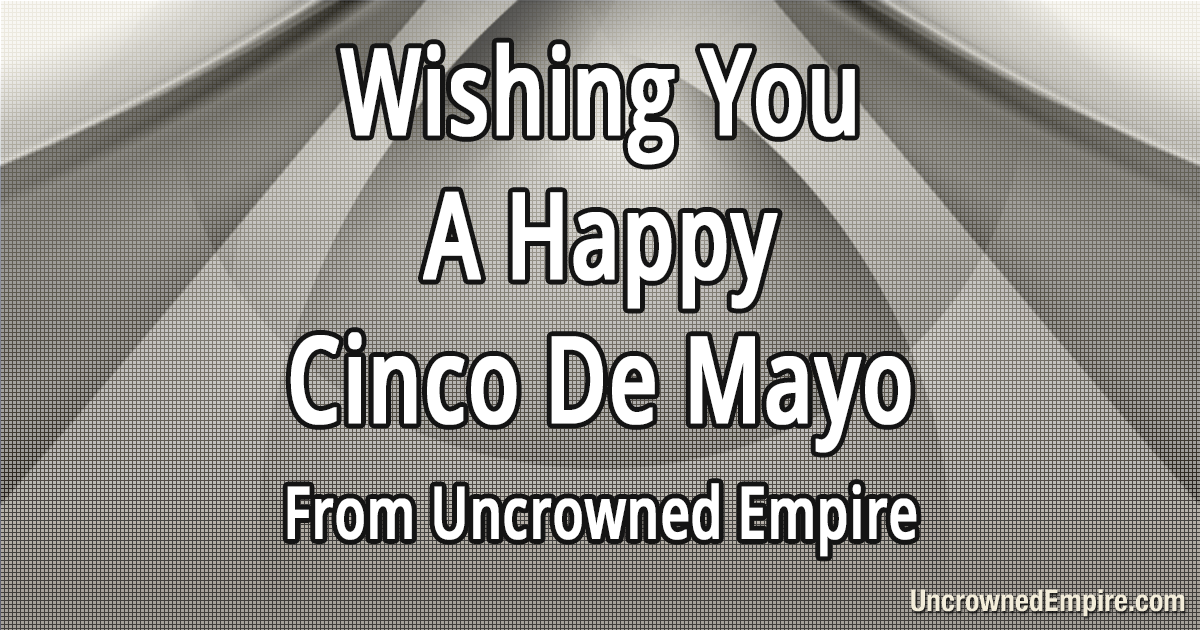-
Posts
132 -
Joined
-
Last visited
-
Days Won
6
Content Type
Profiles
Uncrowned Gaming News
Gaming Resources
Shooter Guides
Events
Forums
Blogs
Store
Posts posted by Uncrowned Bot
-
-

Cinco de Mayo, or translated as the Fifth of May, is the Mexican holiday that celebrates the Mexican victory over the French at the Battle of Puebla during Franco-Mexican war. The day is sometimes referred to as Battle of Puebla Day and always falls on the 5th day of May. Cinco de Mayo is often referred to in the United States as Mexican Independence Day, but this is an incorrect reference as it is a minor holiday in Mexico and is the celebration of a single battle. Mexican Independence Day, or Día de la Independencia, is celebrated on September 16th as the commemoration of Mexico’s declaration of war against the Spanish government in 1810.
The Franco-Mexican war was a joint military response by France, Britain, and Spain who sent military forces to Veracruz, Mexico demanding repayment of loans and other finances due to Mexico’s ongoing financial troubles and defaulting on recent payments. Britain and Spain never engaged in military combat due to negotiations with the Mexican government, however, France decided to use the opportunity to expand their empire into the Mexican owned territory. The Battle of Puebla was a final stand made by a ragtag Mexican military force that was vastly outnumbered and underequipped to face the French army but managed to hold the line against the French invasion. After this battle The United States, who was finally recovering from the Civil War, began to apply political pressure to the French and support for the Mexican military causing the French forces to withdraw.
While in Mexico, Cinco de Mayo is primarily observed in the state of Puebla, where the victory had occurred, the United States began celebrating the holiday around the 1960s as a celebration of Mexican culture and heritage within the United States. Since the 1960s Cinco de Mayo has rapidly grown in popularity within the United States with numerous festivals and events celebrating Mexican traditions and culture within the nation. While the holiday is still officially the commemoration of a victory in a military battle, it is widely regarded has a cultural celebration in modern times here in the United States. Many people connect this holiday with the association of Mexican traditions due to the high number of indigenous Mexicans that fought in the Battle of Puebla.
-
Uncrowned Empire has completed the core development of our first series of websites and they are now officially live! This is huge news for us and we are super excited to start the growing process of each website! Although we are most excited about the communities of people we are creating and to meet all of those who join! Thank you for all of the support!
- Added to Communities by Invision mobile app (Find us in the Android store!)
- Mobile Icons Fixed
- We now have a discord!
- The Uncrowned Legion has it's own discord now!
- Added to Communities by Invision mobile app (Find us in the Android store!)
- Guides are now forum based
- Mobile Icons Fixed
- We now have a discord!
- Class guides are online!
- Added to Communities by Invision mobile app (Find us in the Android store!)
- Forums revamped for better community use
- Guides are now forum based
- Mobile Icons Fixed
- We now have a discord!
Known Issue
-
Easter, the Christian holiday celebrating the resurrection of Jesus Christ, is one of the oldest Christian holidays and is often considered a convergence of Christian, Hebrew, and Pagan cultures. The New Testament of the Bible states that Jesus was crucified by the Romans in roughly 30 A.D. and was resurrected on a Sunday that has become Easter Sunday. Easter day is also the conclusion of a series of events called the “Passion of the Christ”, that is a 40-day long period of fasting, prayer, and sacrifice that begins with Lent.
Officially Easter is one of the most religious and celebrated holidays within the Christian culture however it is also mixed with many traditions that pre-date Christian beliefs from earlier Pagan times and the Jewish holiday of Passover. The origin of the word Easter is still a debated topic and was not the original name for the holiday. The most widely accepted origin of Easter was from the Anglo-Saxon goddess of spring and fertility, Eastre (or Eeostre). However, one of easter's earlier names was “hebdomada alba” which meant “white week” and it is believed that due to translation issues particularly with people speaking Old High German mistakenly translated the word as “Osteun” (which is a plural for the word “dawn”) which became Easter in English.
For those curious, the reasoning Easter is centered around a bunny, or hare, is due to the holiday's heavy Pagan based history. When Easter was first celebrated by Christians its celebrations were based off Pagan festivals and Easter was a festival within itself. In Pagan tradition bunnies are a symbol of many beliefs, but most prominently fertility, and it is logical to utilize them as a symbol for celebrating new life. Bunnies are also an ancient symbol of the moon and the date of Easter is based around the moon. This association with the moon and an association with the bunny’s burrow being connected as a symbol of Jesus emerging from his tomb has kept the bunny well within Easter's traditions.
Easter eggs on the other hand have a less solid of a connection to Easter, although there are many associations to the eggs that could connect them to the ancient holiday. Many ancient cultures believed the world began as an enormous egg, and with many of these cultures having contact with early Christians it is highly plausible the eggs became a symbol of new life just like the bunny. There are also sources that state many ancient cultures, again many that were directly associated with ancient Christians, utilized eggs as gifts during festival's along with some sources stating eating dyed eggs was a common practice during spring festivals and likely just transitioned into an Easter tradition.
While bunnies and eggs are possibly the most common association with Easter, the most Christian association with Easter would be the Easter lamb. The lamb is connected to the Jewish holiday of Passover where families killed a lamb as a sacrifice. According to beliefs, when Jesus Christ became the “Passover Lamb” for everybody the lamb itself became a symbol of his sacrifice.
-

Easter, the Christian holiday celebrating the resurrection of Jesus Christ, is one of the oldest Christian holidays and is often considered a convergence of Christian, Hebrew, and Pagan cultures. The New Testament of the Bible states that Jesus was crucified by the Romans in roughly 30 A.D. and was resurrected on a Sunday that has become Easter Sunday. Easter day is also the conclusion of a series of events called the “Passion of the Christ”, that is a 40-day long period of fasting, prayer, and sacrifice that begins with Lent.
Officially Easter is one of the most religious and celebrated holidays within the Christian culture however it is also mixed with many traditions that pre-date Christian beliefs from earlier Pagan times and the Jewish holiday of Passover. The origin of the word Easter is still a debated topic and was not the original name for the holiday. The most widely accepted origin of Easter was from the Anglo-Saxon goddess of spring and fertility, Eastre (or Eeostre). However, one of easter's earlier names was “hebdomada alba” which meant “white week” and it is believed that due to translation issues particularly with people speaking Old High German mistakenly translated the word as “Osteun” (which is a plural for the word “dawn”) which became Easter in English.
For those curious, the reasoning Easter is centered around a bunny, or hare, is due to the holiday's heavy Pagan based history. When Easter was first celebrated by Christians its celebrations were based off Pagan festivals and Easter was a festival within itself. In Pagan tradition bunnies are a symbol of many beliefs, but most prominently fertility, and it is logical to utilize them as a symbol for celebrating new life. Bunnies are also an ancient symbol of the moon and the date of Easter is based around the moon. This association with the moon and an association with the bunny’s burrow being connected as a symbol of Jesus emerging from his tomb has kept the bunny well within Easter's traditions.
Easter eggs on the other hand have a less solid of a connection to Easter, although there are many associations to the eggs that could connect them to the ancient holiday. Many ancient cultures believed the world began as an enormous egg, and with many of these cultures having contact with early Christians it is highly plausible the eggs became a symbol of new life just like the bunny. There are also sources that state many ancient cultures, again many that were directly associated with ancient Christians, utilized eggs as gifts during festival's along with some sources stating eating dyed eggs was a common practice during spring festivals and likely just transitioned into an Easter tradition.
While bunnies and eggs are possibly the most common association with Easter, the most Christian association with Easter would be the Easter lamb. The lamb is connected to the Jewish holiday of Passover where families killed a lamb as a sacrifice. According to beliefs, when Jesus Christ became the “Passover Lamb” for everybody the lamb itself became a symbol of his sacrifice.
-
President’s Day, or more appropriately called George Washington’s Birthday, is a federal holiday in the United States in honor of first president of the United States. George Washington was born on February 11th, 1731 using the calendar of his time or on February 22nd, 1732 according to the modern calendar, with the later considered his official birthday in most references.
The United States Congress implemented February 22 as a day to honor the former president in 1879 and in 1971 the date of the holiday was changed to the third Monday of February via the Uniform Monday Holiday Act by Congress. Oddly, the new date will always fall between February 15th and February 21st, which will never include Washington’s original or updated birthdays.
-

President’s Day, or more appropriately called George Washington’s Birthday, is a federal holiday in the United States in honor of first president of the United States. George Washington was born on February 11th, 1731 using the calendar of his time or on February 22nd, 1732 according to the modern calendar, with the later considered his official birthday in most references.
The United States Congress implemented February 22 as a day to honor the former president in 1879 and in 1971 the date of the holiday was changed to the third Monday of February via the Uniform Monday Holiday Act by Congress. Oddly, the new date will always fall between February 15th and February 21st, which will never include Washington’s original or updated birthdays.
-

President’s Day, or more appropriately called George Washington’s Birthday, is a federal holiday in the United States in honor of first president of the United States. George Washington was born on February 11th, 1731 using the calendar of his time or on February 22nd, 1732 according to the modern calendar, with the later considered his official birthday in most references.
The United States Congress implemented February 22 as a day to honor the former president in 1879 and in 1971 the date of the holiday was changed to the third Monday of February via the Uniform Monday Holiday Act by Congress. Oddly, the new date will always fall between February 15th and February 21st, which will never include Washington’s original or updated birthdays.
-
Valentine’s Day, also called Saint Valentine’s Day or the Feast of Saint Valentine, is a Western Christian holiday honoring the early Christian martyrs named Saint Valentine. Numerous martyrdom stories connect multiple Saint Valentines to the holiday with the early adaptations referring the saint to the miracle of sight in a blind daughter of his own jailer and later adaptations focused on romance and the addition of “Your Valentine” letters.
Officially the holiday stated as the Feast of Saint Valentine by Pope Gelasius I in 496 AD to honor the passing of Saint Valentine who died February 14th 269 AD. It is estimated that the event became associated with romance and love in the 14th and 15th centuries when the notions of “courtly love” became a basic concept within the event. The event started to become fully associated with love in 18th century England as couples started presenting gifts and flowers to each other and started a tradition of giving cards to their loves known as “valentines”.
Since the 19th century, mass produced valentine’s day cards have become the standard and many now consider the event a “hallmark holiday” as couples spend small fortunes on exchanging gifts. The holiday is celebrated every February 14th but is not a public holiday in any nation.
-

Valentine’s Day, also called Saint Valentine’s Day or the Feast of Saint Valentine, is a Western Christian holiday honoring the early Christian martyrs named Saint Valentine. Numerous martyrdom stories connect multiple Saint Valentines to the holiday with the early adaptations referring the saint to the miracle of sight in a blind daughter of his own jailer and later adaptations focused on romance and the addition of “Your Valentine” letters.
Officially the holiday stated as the Feast of Saint Valentine by Pope Gelasius I in 496 AD to honor the passing of Saint Valentine who died February 14th 269 AD. It is estimated that the event became associated with romance and love in the 14th and 15th centuries when the notions of “courtly love” became a basic concept within the event. The event started to become fully associated with love in 18th century England as couples started presenting gifts and flowers to each other and started a tradition of giving cards to their loves known as “valentines”.
Since the 19th century, mass produced valentine’s day cards have become the standard and many now consider the event a “hallmark holiday” as couples spend small fortunes on exchanging gifts. The holiday is celebrated every February 14th but is not a public holiday in any nation.
-

Valentine’s Day, also called Saint Valentine’s Day or the Feast of Saint Valentine, is a Western Christian holiday honoring the early Christian martyrs named Saint Valentine. Numerous martyrdom stories connect multiple Saint Valentines to the holiday with the early adaptations referring the saint to the miracle of sight in a blind daughter of his own jailer and later adaptations focused on romance and the addition of “Your Valentine” letters.
Officially the holiday stated as the Feast of Saint Valentine by Pope Gelasius I in 496 AD to honor the passing of Saint Valentine who died February 14th 269 AD. It is estimated that the event became associated with romance and love in the 14th and 15th centuries when the notions of “courtly love” became a basic concept within the event. The event started to become fully associated with love in 18th century England as couples started presenting gifts and flowers to each other and started a tradition of giving cards to their loves known as “valentines”.
Since the 19th century, mass produced valentine’s day cards have become the standard and many now consider the event a “hallmark holiday” as couples spend small fortunes on exchanging gifts. The holiday is celebrated every February 14th but is not a public holiday in any nation.
-
Happy Martin Luther King Jr. Day! “Our lives begin to end the day we become silent about things that matter.”
-
Uncrowned Empire has entered the last phase of our beta as things start to come to a completion. Check below for notes on the changes and a list of new features. Feel free to report any bugs you find here or via our support system. Thank you for all of the support!
- Fixed error preventing user registrations.
- Fixed system wide email problems.
- New header image has been added with logo.
- Added holiday effects.
- Added new social media sharing images.
- Added new favicon and app icons.
- All social media accounts have new matching graphic sets.
- Fixed error preventing user registrations.
- New header image has been added with logo.
- Forum has been revamped for better usage.
- Added holiday effects.
- Added new social media sharing images.
- Added new favicon and app icons.
- All social media accounts have new matching graphic sets.
- Fixed error preventing user registrations.
- New header image has been added with logo.
- Added new social media sharing images.
- Added holiday effects.
- Added new favicon and app icons.
- All social media accounts have new matching graphic sets.
Known Issues
- All sites Mobile icons are not displaying correctly.




[Discussion] Happy Cinco de Mayo!
in Gaming News
Posted
Cinco de Mayo, or translated as the Fifth of May, is the Mexican holiday that celebrates the Mexican victory over the French at the Battle of Puebla during Franco-Mexican war. The day is sometimes referred to as Battle of Puebla Day and always falls on the 5th day of May. Cinco de Mayo is often referred to in the United States as Mexican Independence Day, but this is an incorrect reference as it is a minor holiday in Mexico and is the celebration of a single battle. Mexican Independence Day, or Día de la Independencia, is celebrated on September 16th as the commemoration of Mexico’s declaration of war against the Spanish government in 1810.
The Franco-Mexican war was a joint military response by France, Britain, and Spain who sent military forces to Veracruz, Mexico demanding repayment of loans and other finances due to Mexico’s ongoing financial troubles and defaulting on recent payments. Britain and Spain never engaged in military combat due to negotiations with the Mexican government, however, France decided to use the opportunity to expand their empire into the Mexican owned territory. The Battle of Puebla was a final stand made by a ragtag Mexican military force that was vastly outnumbered and underequipped to face the French army but managed to hold the line against the French invasion. After this battle The United States, who was finally recovering from the Civil War, began to apply political pressure to the French and support for the Mexican military causing the French forces to withdraw.
While in Mexico, Cinco de Mayo is primarily observed in the state of Puebla, where the victory had occurred, the United States began celebrating the holiday around the 1960s as a celebration of Mexican culture and heritage within the United States. Since the 1960s Cinco de Mayo has rapidly grown in popularity within the United States with numerous festivals and events celebrating Mexican traditions and culture within the nation. While the holiday is still officially the commemoration of a victory in a military battle, it is widely regarded has a cultural celebration in modern times here in the United States. Many people connect this holiday with the association of Mexican traditions due to the high number of indigenous Mexicans that fought in the Battle of Puebla.
View full article